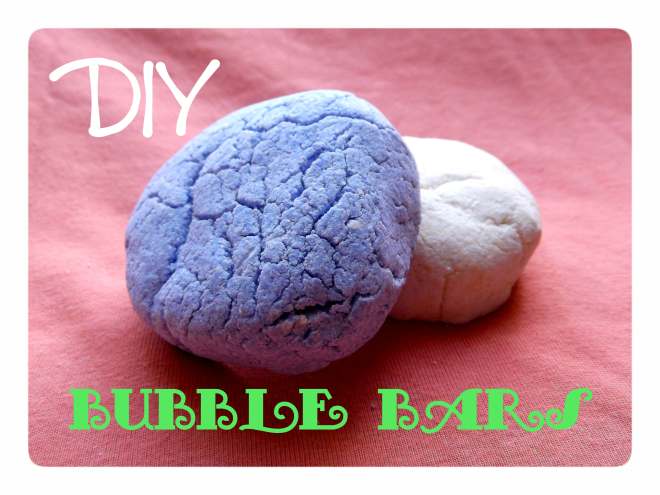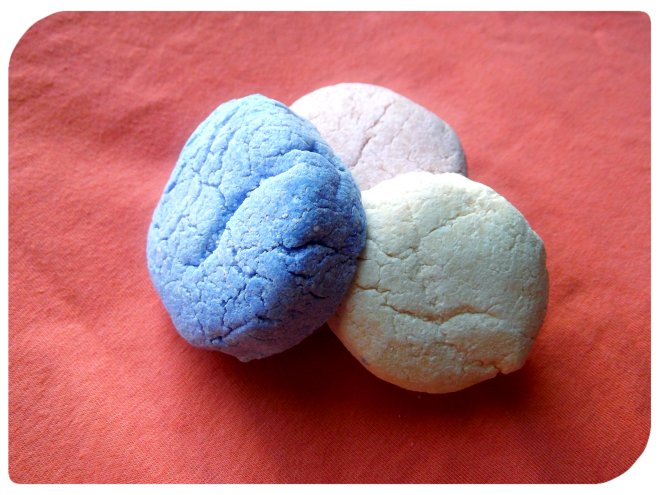I have been trying to remake at home the famous L*sh Bubble Bars, with similar ingredients but with few additions also! 😀
I have to admit that it wasn’t too easy: it was the first time I was using sodium lauroyl sulphoacetate (SLSA – a powder surfactant, which is the main ingredient of this recipe because it is the one which makes bubbles :D) and tartaric acid… plus I had problems with getting the right procedure… but I did it! 😀
Finally ended up with a recipe which left me satisfied and so here I am sharing it with you! 😉
For those of you who don’t know what a BUBBLE BAR is: it is essentially a solid bubble gel, if this makes any sense 😀 You have to make it into small crumbles inside of the tub while you are pouring water and tadaaa… few seconds and your tub will be full of foam and good perfume! 😉
Therefore, if you love foamy luxurious baths, keep reading 😀
The recipe is very very easy but you need all the ingredients listed: if you don’t have them, you won’t get very good results (I know that changing some ingredients in recipes is very tempting… but if you trust me just a little bit I can tell you that I wasted a lot of ingredients before I found out the right proportions… however it is totally your choice if you want to listen to me or not 😀 ).
READY??? 😀
RECIPE (for 1 Kg)
Phase 1
– Sodium Bicarbonate 250
– Tartaric Acid 200
– Oil (grape seed, sunflower, rice, almond… just any oil) 30
Phase 2
– SLSA 200
– Cocamidopropyl Betaine 70 (this ingredient is needed to make the SLSA more mild. If you want to know more about surfactants, you might want to read HERE and HERE)
– Cornstarch 150
Phase 3
– Perfume (enough 😀 )
– Colorant (I used ultramarine colors, Micas are fine and food colorant is fine also but remember that adding anything containing water will spoil your Bubble Bars a little).
– Preservative
How to:
Mix all the ingredients of Phase 1; separately mix all the ingredients of Phase 2. Make sure they are both mixed very well: I ended up using my hands (covered with disposable gloves) and that seems to me to be the best choice.
Check that both the Phase 1 and 2 are quite wet (but not too much): you can check it by squeezing a little bit of these two pastes in your hands: if the paste keeps the shape of your hand, they are perfect, otherwise add a little little amount of oil to Phase 1 and c.betaine to Phase 2!
Now you can mix Phase 1 and 2 together.
The reason why we mix these two Phases separately is very simple: Cocamidopropyl Betaine is a surfactant which is melted into water. If water reaches directly the mixture of Sodium bicarbonate and Tartaric acid, these two would react creating that fizziness which we, instead, want to obtain in the bath tub! 😀
By mixing the Cocamidopropyl Betaine with the cornstarch and the SLSA first, and only secondly together with the Phase 1, instead, the reaction is only partial and won’t spoil your Bubble bars! 😉
Eventually add to the mixture the Phase 3.
You can either shape your bubble bars by hands or press them into a mould (if you do so, you have to let them dry into the mold also). Let them dry for a couple of days and… they are ready! 😀
[notice that they are quite frail in the first few hours after you make them, so make them dry in a safe place 😉 ]
Problems I have encountered with other recipes: the biggest problem is when there is too much free water which reacts with the Phase 1. I ended up with a monstrous paste which was growing and growing 😀 I still used the bubble bars which came out from this but they didn’t melt fast enough in the tub.
This seems to be a good recipe so this is why I decided to share it.
However I believe that a BUBBLE POWDER would be even better… so this is what I am going to study next 😉
Keep in touch and let me know about your experiments! 😀
Ciao! 😀
For more recipes click HERE
To learn how to formulate cosmetics click HERE
For a list of online cosmetic ingredients suppliers click HERE

This work is licensed under a Creative Commons Attribution-NonCommercial-NoDerivatives 4.0 International License.



Good of you to mix the SLSA with an alkamidopropyl betaine. Most of these DIY recipes would use only an anionic surfactant. Sure, they work that way…but to get a given volume & persistence of foam, they wind up with so much total active matter in the bath water that the bath is very soapy & defatting. One DIY formulator even bragged that she could bathe a long time and then splash up the water to re-foam it–fine if you’re washing greasy dishes, but many people’s skin wouldn’t find such a bath very friendly. (Many would tolerate it, though; some people used to bathe in baths sudsed up with soap flakes or powder.) By using a foam stabilizer, you use less TAM to get the bubbles; leave the cleaning for the soap! Decreasing irritancy still further by its being an anionic + betaine combination is icing on the cake.
However, I also have a criticism of the concept of combining foaming & fizzing properties in one tablet: I think it’s a waste. To get the best effect of a bath fizzie, you should already be in the water so it fizzes around you. To get the best effect of a bath foam, you should aerate it well before you get into the water. Try to do both together, and you lose either the fizz or most of the foaming.
Still, to make a tablet that dissolves easily, you need to get a gummy surfactant like CAB adsorbed onto an excess of something solid, and I guess NaHCO3’s as good a choice as many others. (SLSA by contrast is itself VERY dry.) Another advantage of a tablet is that if you’re making them in small quantity, you don’t have to have the ingredients that well mixed. As long as the total tablet has everything for a single use and it holds together, you’re golden; it needn’t be uniform. Making powdered bubble bath or finely granulated bath fizzies is going to be a much greater challenge.
LikeLike
Hello I just wanted to say thank you so much for sharing your recipe Iam new to the bath and body world and this is the first recipe that I have came
across that’s easy to follow and my bars look great …. The world wouldn’t be complete without people like you sharing there recipes and ideas so thanks again 😘
LikeLike
😀 thanks for the kind words 😀
LikeLike
I am so happy for you a lot of people says a nice words for you you deserve more believe me T_T love these bubbles
LikeLike
Thanks for the recipe and such great information. I wanted to try a recipe which called for 1cup of SLSA but I only have Sodium Lauroyl sarcosinate. Can i use the same amount. thanks
LikeLike
It depends… I believe your Sodium Lauroyl Sarcosinate is liquid?
Or is it in powder dorm? Because I have never seen it retailed in powder form.
You should follow a recipe in percentages, not in cups and spoons as those are never accurate, so use a scale and never cups! 😉
LikeLike
Hi there,
I followed the recipe and it ended up a little too dry to form any shape (it just crumbled). Are there any ingredients you would advise adding to make it more workable?
LikeLike
no, you simply added too little water. you can spray a little more water or oil!
LikeLike
hey, I’m Gabriela from Chile and i’m trying to make my own bath products, so i was looking for a perf bubble bar recipe and then your website came in. The only problem that i have is that i can’t found the cream of tartar :((, can i just ignore that from the list? if yes, how much of the wet ingredients i have to add?.
I would be so thankful if you could help me!!
LikeLike
Hi Gabriela!
Can you find citric acid?
LikeLike
Hi, I just came across your website and recipe for the bubble bath bars. I’m looking to make something special for my teenage daughter. I have never made any type of homemade products before so this is all new to me. In the recipe I see numbers behind the ingredients. Are the numbers ounces, grams, mililleters or percentages? I’m a little confused to the amounts of each ingredient to use.
LikeLike
On my blog all formulas are in % based on weight (not volume).
This formula, however, as you can read at the very beginning, is for one Kg batch (cause 100 grams is a very small amount for this kind of formula).
So all the numbers are grams.
If you want the percentage, just divide each quantity by 100.
LikeLike
Actually, the correct way to work out percentage of ingredients would be to add total grams of formula. The divide each individual ingredient by the total amount then multiple x 100.
Bicarb 200 g
tartaric Acid 200
Oil 30
Phase 2
SLSA 200
Cocamidopropyl Betaine 70
Cornstarch 150
Total is 850g
Now I know you said add as much fragrance that is enough which is a bit interesting because I would think you would advise people to check IFRA standards for fragrance amounts. The International Fragrance Association (IFRA) Standards work to regulate the safe use of fragrance materials that are skin sensitisers and irritants.
Your formula in % would be:
Bicarb 200/850×100 = 23.5%
Cream of tartar 200/850×100 = 23.5%
Oil 30/850×100 = 3.5%
SLSA 200/850×100 = 23.5%
Cocamidopropyl 70/850×100= 8.0%
Cornflour /850×100 =17.5
Fragrance 0.5%
If you just divided by 100 the percentage would not be correct
20% bicarb 20% tartar 3% oil 20% slsa 7% betaine 15% cornflour which only adds up to 85% and fragrance couldn’t make up the 15٪
LikeLiked by 1 person
You are right, this formula is NOT in percentages as there was a mistake… And to me it is OBVIOUS that fragrance must be used ENOUGH (WITHIN THE SAFETY STANDARDS) like for any ingredient that I use (I always follow the suggested % range).
This said, it is a very old formula, this blog is open only for follow up comments, so I am not taling the time to change it, but thank you for pointing that mistake out.
LikeLike